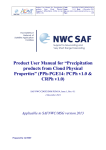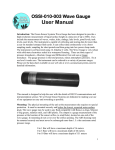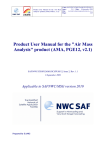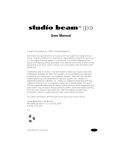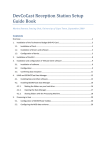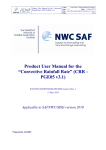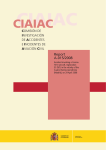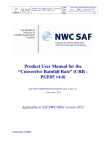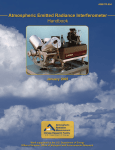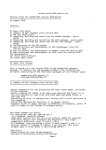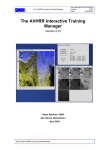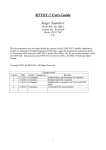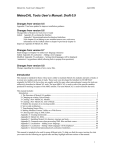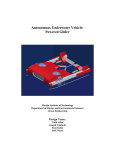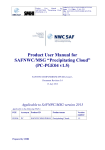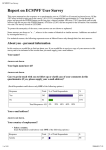Download Product User Manual for “SEVIRI Physical Retrieval
Transcript
Product User Manual for “SEVIRI Physical Retrieval Product” (SPhR - PGE13 v1.2) Code: SAF/NWC/CDOP/INM/SCI/PUM/13 Date: 15 February 2012 Issue: 1.2 File: SAF-NWC-CDOP-INM-SCI-PUM-13_v1.2 Page: 1/33 Product User Manual for “SEVIRI Physical Retrieval Product” (SPhR PGE13 v1.2) SAF/NWC/CDOP/INM/SCI/PUM/13, Issue 1, Rev.2 15 February 2012 Applicable to SAFNWC/MSG version 2012 Prepared by AEMET Product User Manual for “SEVIRI Physical Retrieval Product” (SPhR - PGE13 v1.2) Code: SAF/NWC/CDOP/INM/SCI/PUM/13 Date: 15 February 2012 Issue: 1.2 File: SAF-NWC-CDOP-INM-SCI-PUM-13_v1.2 Page: 2/33 REPORT SIGNATURE TABLE Function Name M. A. Martinez (AEMET) Prepared by Ramiro Romero (AEMET) Signature Date 15 February 2012 Jun Li (CIMSS) Reviewed by Authorised by Marcelino Manso Pilar Fernández SAFNWC Project Manager 15 February 2012 15 February 2012 Product User Manual for “SEVIRI Physical Retrieval Product” (SPhR - PGE13 v1.2) Code: SAF/NWC/CDOP/INM/SCI/PUM/13 Date: 15 February 2012 Issue: 1.2 File: SAF-NWC-CDOP-INM-SCI-PUM-13_v1.2 Page: 3/33 DOCUMENT CHANGE RECORD Version Date Pages 1.0d 9 April 2010 36 1.0 21 May 2010 32 1.1 1 April 2011 32 1.2 15 February 2012 33 CHANGE(S) Initial version. Submitted to DRI-2010 Review Board Corrected after DRI 2010 Updated version for 2011. New emissivity files to operate with MSG1, MSG2 and Rapid Scan mode Updated version for 2012. Update of BIAS correction coefficients for the 6 SEVIRI IR channels for MSG-1 and MSG-2. New FG non-linear regression coefficients . Computation of Empirical Orthogonal Functions(EOFs) for temperature and log(q) from ECMWF. New inverse covariance matrix computed and code update to manage inverse covariance matrix as configurable parameter. Product User Manual for “SEVIRI Physical Retrieval Product” (SPhR - PGE13 v1.2) Code: SAF/NWC/CDOP/INM/SCI/PUM/13 Date: 15 February 2012 Issue: 1.2 File: SAF-NWC-CDOP-INM-SCI-PUM-13_v1.2 Page: 4/33 Table of contents 1. INTRODUCTION ...................................................................................................................6 1.1 SCOPE OF THE DOCUMENT .......................................................................................................6 1.2 SOFTWARE VERSION IDENTIFICATION .....................................................................................6 1.3 DEFINITIONS, ACRONYMS AND ABBREVIATIONS ......................................................................7 1.4 REFERENCES ...........................................................................................................................8 1.4.1 Applicable Documents...................................................................................................8 1.4.2 Reference Documents ....................................................................................................8 2. DESCRIPTION OF PGE13 SEVIRI PHYSICAL RETRIEVAL (SPHR) PRODUCT ...9 2.1 GOAL OF PGE13 SEVIRI PHYSICAL RETRIEVAL (SPHR) PRODUCT ..............................9 2.2 OUTLINE OF THE PGE13 SPHR ..................................................................................................9 2.3 DESCRIPTION OF PGE13 SPHR OUTPUTS ..............................................................................12 2.3.1 PGE13 SPhR Main outputs description. .....................................................................12 2.3.2 PGE13 SPhR Main outputs: HDF-5 files descripition................................................13 2.3.3 Optional binary files outputs. ......................................................................................15 3. 3.1 3.2 IMPLEMENTATION OF THE PRODUCT ......................................................................19 THE PGE13 INSTALLATION AND PREPARATION STEP .............................................................19 THE PGE13 EXECUTION STEP ...............................................................................................19 4. DESCRIPTION OF INPUTS, COEFFICIENTS FILES AND CONFIGURABLE PARAMETERS .............................................................................................................................21 4.1 DESCRIPTION OF INPUTS FOR PGE13 SPHR ...............................................................21 4.1.1 Region configuration file.............................................................................................21 4.1.2 SEVIRI BT: HRIT SEVIRI files....................................................................................21 4.1.3 PGE01 Cloud Mask (CMa). ........................................................................................22 4.1.4 Background NWP GRIB files. .....................................................................................22 4.1.5 Geographical data from NWCSAF functions. .............................................................23 4.2 DESCRIPTION OF COEFFICIENTS FOR PGE13 SPHR..................................................23 4.2.1 Bias correction coefficients. ........................................................................................23 4.2.2 PGE13 First Guess regression coefficients file...........................................................23 4.2.3 PGE13 Empirical Orthogonal functions (EOF) for T and q.......................................24 4.2.4 PGE13 Inverse Covariance Matrix. ............................................................................24 4.2.5 PGE13 Band coefficients file for noise error adjustment............................................24 4.2.6 Surface IR emissivity atlas files. ..................................................................................25 4.2.7 RTTOV-9.3 coefficients ...............................................................................................25 4.2.8 Ancillary data sets. ......................................................................................................25 4.3 LIST OF PGE13 SPHR CONFIGURABLE PARAMETERS ............................................................26 4.3.1 PGE13 SPhR Model Configuration File. ....................................................................26 5. PGE13 SPHR PRODUCT VALIDATION..........................................................................28 5.1 SUMMARY OF PGE13 SPHR PRODUCT VALIDATION ...............................................................28 5.2 PGE13 SPHR PRODUCT ASSUMPTIONS AND LIMITATIONS .....................................................28 5.2.1 Assumptions.................................................................................................................28 5.2.2 Limitations...................................................................................................................28 6. EXAMPLES OF PGE13 SPHR VISUALISATION...........................................................30 7. REFERENCES ......................................................................................................................33 Product User Manual for “SEVIRI Physical Retrieval Product” (SPhR - PGE13 v1.2) Code: SAF/NWC/CDOP/INM/SCI/PUM/13 Date: 15 February 2012 Issue: 1.2 File: SAF-NWC-CDOP-INM-SCI-PUM-13_v1.2 Page: 5/33 List of tables and figures Table 1: List of Applicable Documents.............................................................................................8 Table 2: Maximum and Minimum values for each parameter ........................................................14 Table 3: 3D binary file with END PROFILE (SAVE_END_PROF) description...........................16 Table 4: 3D binary files (SAVE_ PROF =1) with temperature and humidity profiles at different steps of the PGE13 algorithm description. ..............................................................................17 Table 5: binary files only at clear FOR position (SAVE_ PROF =2) with T and q profiles at different steps of the PGE13 algorithm description. ...............................................................18 Table 6: Summary of the PGE13 SPhR statistical parameters in period January 2009 to December 2009 for 1 out 2 pixels synthetic dataset. ................................................................................28 Figure 1: PGE13 SPhR execution outline .......................................................................................10 Figure 2: PGE13 SPhR product file structure .................................................................................15 Figure 3: IDV visualization of retrieved q profiles with netCDF for 25th May 2009 at 12 UTC....16 Figure 4: REGION and fields from ECMWF used in NWCSAF Reference system. .....................23 Figure 5: Example of PGE13 SPhR_BL from 12 UTC on 23 July 2009 produced from SEVIRI on MSG2. .....................................................................................................................................30 Figure 6: Example of PGE13 SPhR_ML from 12 UTC on 23 July 2009 produced from SEVIRI on MSG2. .....................................................................................................................................30 Figure 7: Example of PGE13 SPhR_HL (23 July 2009 12 UTC) produced from MSG2 SEVIRI on MSG2. .....................................................................................................................................31 Figure 8: Example of PGE13 SPhR_TPW (23 July 2009 1200 UTC) produced from SEVIRI on MSG2. .....................................................................................................................................31 Figure 9: Example of PGE13 SPhR_LI (23 July 2009 12 UTC) produced from SEVIRI on MSG2. .................................................................................................................................................31 Figure 10: Example of PGE13 SPhR_SHW (23 July 2009 12 UTC) produced from SEVIRI on MSG2. .....................................................................................................................................32 Figure 11: Example of PGE13 SPhR_KI (23 July 2009 12 UTC) produced from SEVIRI on MSG2. .....................................................................................................................................32 Product User Manual for “SEVIRI Physical Retrieval Product” (SPhR - PGE13 v1.2) Code: SAF/NWC/CDOP/INM/SCI/PUM/13 Date: 15 February 2012 Issue: 1.2 File: SAF-NWC-CDOP-INM-SCI-PUM-13_v1.2 Page: 6/33 1. INTRODUCTION The EUMETSAT Satellite Application Facilities (SAFs) are dedicated centres of excellence for the processing of satellite data, and form an integral part of the distributed Eumetsat Application Ground Segment. SAFs are also dedicated centres for software development. This documentation is provided by the SAF on Support to Nowcasting and Very Short Range Forecasting, NWCSAF. The main objective of the NWCSAF is to provide, develop and maintain software packages to be used with operational meteorological satellite data for nowcasting applications by National Meteorological Services. More information about the project can be found at the NWCSAF webpage, http://www.nwcsaf.org. This document is applicable to the NWCSAF processing package for Meteosat Second Generation satellites, NWCSAF/MSG. 1.1 SCOPE OF THE DOCUMENT This document is the Product User Manual (PUM) for the PGE13 SEVIRI Physical Retrieval (SPhR) product of the NWCSAF/MSG software package. It describes the goal and characteristics of the PGE13 SPhR product, including the needed input data and the resulting outputs. It also provides comprehensive information on the algorithm implementation. 1.2 SOFTWARE VERSION IDENTIFICATION This document describes the algorithm implemented in the PGE13 SPhR version v1.2 included in the NWCSAF/MSG v2012 software package delivery. Product User Manual for “SEVIRI Physical Retrieval Product” (SPhR - PGE13 v1.2) Code: SAF/NWC/CDOP/INM/SCI/PUM/13 Date: 15 February 2012 Issue: 1.2 File: SAF-NWC-CDOP-INM-SCI-PUM-13_v1.2 Page: 7/33 1.3 DEFINITIONS, ACRONYMS AND ABBREVIATIONS ABI AEMET AIRS AMSR-E ATBD BL BT CDOP CIMSS CMa CM SAF DEM ECMWF EOF EUMETSAT FOR FOV GTOPO 30 HDF HL HRIT IASI INM IR KI LI LPW ML MODIS MPEF MSG NWC SAF NWP PCA PGE RAOB RTTOV SAF SEVIRI SG SAI SHW SPhR SVD SW TBC TBD TPW URD VSA Advanced Baseline Imager Agencia Estatal de Meteorología (former INM) Atmospheric InfraRed Sounder Advanced Microwave Scanning Radiometer - EOS Algorithm Theoretical Basis Document Boundary Layer (1013hPa-850 hPa) Brightness Temperature Continuous Development and Operational Phase Cooperative Institute for Meteorological Satellite Studies Cloud Mask (also PGE01) Climate Monitoring SAF Digital Elevation Model European Centre for Medium range Weather Forecast Empirical Orthogonal Functions European Meteorological Satellite Agency Field of Regard Field of View Global 30 Arc Second Elevation Data - USGS - EROS Data Center Hierarchical data Format High Layer (<500 hPa) High Rate Information Transmission Infrared Atmospheric Sounding Interferometer Instituto Nacional de Meterología Infrared K-Index Lifted Index Layer Precipitable Water Middle Layer (850hPa-500hPa) Moderate Resolution Imaging Spectroradiometer Meteorological Product Extraction Facilities Meteosat Second Generation SAF on support NoWCasting and VSRF Numerical Weather Prediction Principal Component Analysis Product Generation Element Radiosonde Observation Rapid Transmissions for TOVs Satellite Application Facility Spinning Enhanced Visible & Infrared Imager Steering Group Stability Analysis Imagery Showalter Index SEVIRI Physical Retrieval Software Version Description Software To Be Confirmed To Be Determined Total Precipitable Water Users Requirement Document Visiting Scientist Activity Product User Manual for “SEVIRI Physical Retrieval Product” (SPhR - PGE13 v1.2) Code: SAF/NWC/CDOP/INM/SCI/PUM/13 Date: 15 February 2012 Issue: 1.2 File: SAF-NWC-CDOP-INM-SCI-PUM-13_v1.2 Page: 8/33 1.4 REFERENCES 1.4.1 Applicable Documents Ref. [AD.1] [AD.2] [AD.3] [AD.4] [AD.5] [AD.6] [AD.7] [AD.8] Title Software User Manual for the SAFNWC/MSG Application: Software Part Algorithm Theoretical Basis Document for “PGE13 SEVIRI Physical Retrieval” (SPhR– PGE13 v1.2 Interface Control Document for the External and Internal Interfaces of the SAF NWC/MSG SAFNWC/MSG Output Products format definition Architectural Design Document for the INM related PGEs of the SAFNWC/MSG Software Version Description Document for the SAFNWC/MSG Application Validation Report for “PGE13 SEVIRI Physical Retrieval” (SPhR– PGE13 v1.2) NWCSAF Product Requirements Document Code SAF/NWC/CDOP/INM/SW/SUM/2 Vers 6.0 Date 15/12/11 1.2 15/02/12 SAF/NWC/CDOP/INM/SW/ICD/1 6.0 15/12/11 SAF/NWC/CDOP/INM/SW/ICD/3 6.0 15/12/11 SAF/NWC/CDOP/INM/SW/AD/4 6.0 15/02/12 SAF/NWC/CDOP/INM/SW/SVD/5 6.0 15/12/11 1.0 15/02/12 SAF/NWC/CDOP/INM/SCI/ATBD/13 SAF/NWC/CDOP/INM/SCI/VR/11 SAF/NWC/CDOP/INM/MGT/PRD Table 1: List of Applicable Documents 1.4.2 Reference Documents Ref. [RD.1] [RD.2] Title Table 2: List of Reference Documents 1.2 17/11/11 Product User Manual for “SEVIRI Physical Retrieval Product” (SPhR - PGE13 v1.2) Code: SAF/NWC/CDOP/INM/SCI/PUM/13 Date: 15 February 2012 Issue: 1.2 File: SAF-NWC-CDOP-INM-SCI-PUM-13_v1.2 Page: 9/33 2. DESCRIPTION OF PGE13 SEVIRI PHYSICAL RETRIEVAL (SPHR) PRODUCT 2.1 GOAL OF PGE13 SEVIRI PHYSICAL RETRIEVAL (SPHR) PRODUCT The PGE13 SEVIRI Physical Retrieval (SPhR) product aims to provide information about water vapour and thermal stability distributions on clear air pixels from MSG SEVIRI infrared channels and NWP fields. Products are generated at high spatial and temporal resolution to support real time meteorological applications. The main outputs provided are: Total Precipitable Water (TPW), Layer Precipitable Water (LPW) in three layers (low layer [surface pressure-850 hPa], middle layer [850 hPa-500 hPa] and high layer [<500 hPa]), Lifted Index (LI), Showalter Index (SHW) and K-index (KI). These main outputs are computed from the retrieved profiles of temperature and humidity. As additional outputs, PGE13 SPhR also provides the differences between the above parameters and the similar ones computed directly from forecasted NWP fields. Quality control information parameters are also included in the product output. Besides the above main output parameters, PGE13 SPhR can be optionally configured to save intermediate results that can be useful for debugging purposes or to feed new user applications. PGE13 SPhR products are useful in nowcasting applications, used in synergy with other data available to the forecaster. Since the physical basis of temperature and humidity retrieval is based in the minimization of the error between the SEVIRI BTs and the synthetic BTs calculated from the profiles and taking into account the limited number of channels and the spectral information of the SEVIRI instrument, the PGE13 SPhR only can slightly improve the humidity profiles beyond of the background NWP in middle and high levels. Despite of this the retrieved fields have a higher spatial resolution compared with the forecast. This fact must be taken into account by the users when the PGE13 SPhR outputs are used in nowcasting applications. 2.2 OUTLINE OF THE PGE13 SPHR As a whole, PGE13 SPhR code is designed in a modular way, so that it can be easy to handle and modify it. The algorithm of the PGE13 SPhR is based on physical retrieval and it is described in [AD.2]. In this section only a brief outline and the points related to process of the data is provided. For the selected region, the initialization gives access to SEVIRI BTs, PGE01 Cloud Mask (CMa), satellite zenith angle and ancillary data (topographic data, land-sea mask, longitude, latitude). Only if the pixel or the Field Of Regard (FOR), in case of MxM pixels processing, is labelled as clear air and the satellite zenith angle of this pixel or FOR is below the configurable maximum zenith threshold, the Physical Retrieval module is applied and the PGE13 TPW, LPWs, LI, SHW and KI parameters are calculated for this pixel or FOR. The main input values are the BTs from five SEVIRI infrared channels (centred at 6.2, 7.3, 10.8, 12.0 and 13.4 μm) and forecasted NWP fields which are used as background information. PGE13 SPhR also uses a land-sea mask as static input information and land emissivity maps precomputed for each IR SEVIRI channel and for every month of the year. Cloud Mask (CMa) computed by PGE01 is used as mandatory input to PGE13 SPhR and the process is only performed for pixels, or FOR (in case of MxM pixels processing), labelled as clear air. Product User Manual for “SEVIRI Physical Retrieval Product” (SPhR - PGE13 v1.2) Code: SAF/NWC/CDOP/INM/SCI/PUM/13 Date: 15 February 2012 Issue: 1.2 File: SAF-NWC-CDOP-INM-SCI-PUM-13_v1.2 Page: 10/33 TPW IR13.4 Spatial interpolation BL (sfc-850) IR12.0 HRIT images ML (850-500) IR10.8 PGE13 WV7.3 H5 HL (500-top) YYYYMMDDhhmm region config_file LI WV6.2 Ancillary & coefficients Lon, lat, zenith Bias correction, regression, EOF, etc PGE01 Cloud Mask SHOWALTER K-INDEX + differences (phy. Ret –NWP) Figure 1: PGE13 SPhR execution outline The whole process includes the following main steps: 1. Pre-processing: • Initialisation: reading of processing options from the configuration file, reading of all coefficient file names, get IR emissivity maps for region, initialisation of RTTOV-9.3, obtention of calibrated SEVIRI BTs and associated geographical ancillary data for region to process and reading of PGE01 CMa for region. • Optional thinning of SEVIRI BT to process on FOR of M x M pixels (M is a configurable parameter in the configuration file). Two methods are available to calculate BTs of the FOR: 1) mean value of clear pixels BTs on FOR or 2) BTs of the warmest clear pixel at IR10.8. Keywords: LSIZE_FOR, CSIZE_FOR and FOR_METHOD • To get collocated background NWP forecast temperature and moisture profiles. Background NWP fields of temperature and humidity (T+00 to T+24 hours range forecast) are spatially, temporally and vertically interpolated. Conversion from relative humidity to specific humidity is also made at this step. The spatial (horizontal) interpolation to the FOR position is calculated outside of PGE13 SPhR with common functions of NWCSAF library. The interpolation in the vertical is made assuming the 43 pressure levels of RTTOV as fixed levels. • Bias adjustment of SEVIRI BTs. The bias correction regression coefficients are read from the configuration file and BT bias correction is made. Note: the SEVIRI BTs bias correction coefficients calculated with ECMWF model data from 15 vertical levels are written in the default configuration file. By editing this configuration file, users can apply their own BT bias correction if available or even they have the possibility not to use bias correction by fixing SCALE keyword to 1 and OFFSET keyword to 0. Product User Manual for “SEVIRI Physical Retrieval Product” (SPhR - PGE13 v1.2) • 2. Code: SAF/NWC/CDOP/INM/SCI/PUM/13 Date: 15 February 2012 Issue: 1.2 File: SAF-NWC-CDOP-INM-SCI-PUM-13_v1.2 Page: 11/33 Execution of non linear regression to calculate the first guess profiles of temperature and specific humidity using as main inputs: a) bias corrected SEVIRI BTs and b) the background NWP temperature and specific humidity profiles spatially, temporally and vertically interpolated. Processing: • If the calculated error between RTTOV BTs from first guess profile and SEVIRI BTs (over non window channels) are greater than a predefined threshold the Physical Retrieval module is executed (keyword: BT_RMS_THRESHOLD). In the Physical Retrieval Module the physical retrieval is one minimisation and iterative process (see [AD.2]); the physical retrieval iterative process is executed while the error between SEVIRI BTs and synthetic RTTOV calculated from the (T, q) profile after the iteration is greater than a trheshold (keyword: MAX_RESIDUAL) and while the maximum number of iterations is not reached (keyword: MAX_ITERATIONS) • To check if the retrieved profiles of temperature and specific humidity are between limits and they have physical meaningful. • To perform direct calculation of TPW, LPWs, LI, SHW and KI parameters at FOR from the retrieved profiles of T and q. • To compute the differences between the products (TPW, LPWs, LI, SHW and KI) calculated from retrieved profiles of T and q, and the ones calculated from the background NWP profiles of T and q. o Optional writing of the intermediate T and q profiles. The profiles in the 43 RTTOV levels at the different algorithm steps (after physical retrieval, after iterations, after First-Guess or the background NWP) can be written in the $SAFNWC/tmp on binary files after activation in the configuration file. 3. Post-processing: • Quality control: Several quality flags have been added to the output product. • Filling clear pixels inside the FOR: The default method is to copy the same value to all clear pixels in the FOR. The other configurable option is to write the output only at the clear pixel position (the warmest pixel in the case of the BTs of the warmest clear pixel at IR10.8) • Over cloudy pixels, the IR BT degraded to 7 bits (range [128 – 255]) values for the channel included in the configuration file is stored. This will be later used to generate adequate images in which cloudy pixels are grey scaled and clear pixels are colour scaled • The output is coded as images in HDF5 format file. Product User Manual for “SEVIRI Physical Retrieval Product” (SPhR - PGE13 v1.2) Code: SAF/NWC/CDOP/INM/SCI/PUM/13 Date: 15 February 2012 Issue: 1.2 File: SAF-NWC-CDOP-INM-SCI-PUM-13_v1.2 Page: 12/33 2.3 DESCRIPTION OF PGE13 SPHR OUTPUTS The main outputs provided are parameters informing about the water vapour content in the vertical column (total and in selected thickness) and about the atmospheric thermal stability. These parameters are computed using the final retrieved temperature and humidity profiles. As additional outputs, PGE13 SPhR also provides the differences between the above parameters, computed from the final retrieved profiles, and the similar ones computed from the forecasted background profiles. These deviations are important for (1) signalling areas with discrepancies between model forecast and the observations and (2) show the added value of SEVIRI observations. Optionally, PGE13 SPhR can be configured to keep the final retrieved profiles and the intermediate profiles. This allows users (1) to feed new applications or to compute specific stability indices at their own and (2) to debug, testing and monitoring PGE13 SPhR performances. 2.3.1 PGE13 SPhR Main outputs description. 2.3.1.1 Introduction: Humidity and Thermal Stability parameters 2.3.1.1.1 Humidity parameters An evaluation of humidity distribution is critical in order to determine the possibilities of convection, severe weather and heavy precipitation. Storms usually develop where humidity is already high or where some mechanism makes it to increase. Precipitable water is a measurement of the water vapor mass contained in a vertical column of atmosphere of section unit and thickness limited between two pressure levels. The units are kg/m2 (mm are commonly used in operational meteorology) Four different precipitable water parameters, defined as function of two selected pressure levels, are considered of interest: Total Precipitable Water, TPW: pmax = psurface and pmin = 0 Low Layer Precipitable Water, BL: pmax = psurface and pmin = 850 hPa Medium Layer Precipitable Water, ML: pmax = 850 hPa and pmin = 500 hPa High Layer Precipitable Water, HL: pmax = 500 hPa and pmin = 0 Most of the contribution to TPW comes from a layer between surface and 500 hPa. 2.3.1.1.2 Thermal stability parameters Thermal stability indices were developed in the past to support storms and severe weather forecast using as main input local radiosonde profiles of temperature and humidity. It is important to remark as introductory note that the use of these indices needs to be supported by previous experience in the use of the more appropriate ones to each specific region and weather regimes. Among all the instability indices, Lifted Index (Galway, 1956) and (Miller, 1972), the Showalter Index (Showalter, 1947) and the K-Index (George, 1960) has been chosen to codify in the 2010 version. These indices are widely used in operational meteorology. There are several thermal stability indices defined as the difference between the air environment temperature at 500 hPa and the temperature of an air parcel representative of the properties of low levels, lifted up to the 500 hPa. The indices have negative values when the lifted parcel arrives warmer than the environment as it means buoyancy and hence instability. The units are Kelvin (ºC is commonly used also in operational meteorology). Product User Manual for “SEVIRI Physical Retrieval Product” (SPhR - PGE13 v1.2) Code: SAF/NWC/CDOP/INM/SCI/PUM/13 Date: 15 February 2012 Issue: 1.2 File: SAF-NWC-CDOP-INM-SCI-PUM-13_v1.2 Page: 13/33 Thermal Stability Index = Tenv500 - Tparc500 In the case of Lifted Index (LI), the temperature and humidity of the virtual lifted parcels are the average of the lowest 100 hPa (or 1000 m). Next table provides empirical relation between LI values and the stability degree: LI value V>0 -3 <= v < 0 -6 <= v < -3 -9 <= v < -6 v < -9 Stable Slightly Unstable Unstable Very Unstable Extremely Unestable In the case of Showalter Index (SHW), the lifted parcel represents the environment at 850 hPa. Next table provides empirical relation between SHW values and the stability degree: Showalter value v>0 -3 <= v < 0 -6 <= v < -4 v < -6 Stable Marginal instability Large instability Extreme instability K Index (KI) measures the thermal stability in function of the vertical gradient of temperature and humidity content in low levels. KI = ( T850 - T500 ) + ( Td850 - DD700 ) where: DD700 = (T700 - Td700 ) The following table provides empirical relation between KI values and storm probability: K-Index value v < 15 15 < v <= 20 21 < v <= 25 26 < v <= 30 31 < v <= 35 36 < v <= 40 v > 40 Storm probability ≈0% < 20% 20 – 40 % 40 – 60 % 60 – 80 % 80 – 90 % > 90 % 2.3.2 PGE13 SPhR Main outputs: HDF-5 files descripition The following fields are calculated for clear pixels in the current version: 1. SPhR_TPW: Total precipitable water (PSurface - PTOA) from the retrieved profiles of temperature and humidity. 2. Precipitable water in three layers LPW (SPhR_BL: PSurface - 850 hPa, SPhR_ML: 850 500, SPhR_HL: 500 - PTOA) from the retrieved profiles of temperature and humidity. 3. SPhR_LI: Lifted Index from the retrieved profiles of temperature and humidity. 4. SPhR_SHW: Showalter Index from the retrieved profiles of temperature and humidity. 5. SPhR_KI: K-Index from the retrieved profiles of temperature and humidity. 6. SPhR_DIFFTPW: Differences between TPW from retrieved profile and TPW from NWP profiles. 7. SPhR_DIFFBL, SPhR_DIFFML, SPhR_DIFFHL: Differences between LPWs from retrieved profile and LPWs from background NWP profiles. Product User Manual for “SEVIRI Physical Retrieval Product” (SPhR - PGE13 v1.2) Code: SAF/NWC/CDOP/INM/SCI/PUM/13 Date: 15 February 2012 Issue: 1.2 File: SAF-NWC-CDOP-INM-SCI-PUM-13_v1.2 Page: 14/33 8. SPhR_DIFFLI, SPhR_DIFFKI, SPhR_DIFFSHW: Differences between instability indices from retrieved profile and instability indices from background NWP profiles. 9. Quality Flags: SPhR_QUALITY, SPhR_SFLAG fields. 10. Configurable IR channel BT degraded to 7 bits only in cloudy pixels. It is important to remark that taking advantage of the PGE13 SPhR retrieved T/H profiles, new thermal stability indices can be added as well as the atmospheric layers of the precipitable water can be modified. The fields are later on scaled in order to store them in 7 bits, being the values in the range [8-127]. The HDF-5 format files scales have the following minima and maxima values. Parameter minimum maximum SPhR_BL 0 35 SPhR_ML 0 45 SPhR_HL 0 8 SPhR_TPW 0 70 SPhR_LI 25 -15 SPhR_KI 0 60 25 -15 SPhR_DIFFBL -1.5 1.5 SPhR_DIFFML -2.5 2.5 SPhR_DIFFHL -0.75 0.75 -3 3 SPhR_DIFFLI -2.5 2.5 SPhR_DIFFKI -7 7 -2.5 2.5 SPhR_SHW SPhR_DIFFTPW SPhR_DIFFSHW Table 2: Maximum and Minimum values for each parameter The HDF-5 output files are stored in $SAFNWC/export/PGE13. Detailed information on the HDF-5 format file can be found in [AD.4]. Their structure is schematically shown in the following figure: Product User Manual for “SEVIRI Physical Retrieval Product” (SPhR - PGE13 v1.2) 01-PALETTE is applied to the BL 02-PALETTE is applied to the ML 03-PALETTE is applied to the HL 04-PALETTE is applied to the LI 05-PALETTE is applied to the TPW 06-PALETTE is applied to the SPhR_DIFFBL 07-PALETTE is applied to the SPhR_DIFFML Code: SAF/NWC/CDOP/INM/SCI/PUM/13 Date: 15 February 2012 Issue: 1.2 File: SAF-NWC-CDOP-INM-SCI-PUM-13_v1.2 Page: 15/33 08-PALETTE is applied to the SPhR_DIFFHL 09-PALETTE is applied to the SPhR_DIFFLI 10-PALETTE is applied to the SPhR_DIFFKI 11-PALETTE is applied to the SPhR_DIFFTPW 12-PALETTE is applied to the SPhR_DIFFSHW 13-PALETTE is applied to the SPhR_KI 14-PALETTE is applied to the SPhR_SHW Figure 2: PGE13 SPhR product file structure 2.3.3 Optional binary files outputs. Due to the fact that PGE13 SPhR is executed locally and in order to allow users to debug their local installations or generate new parameters or instability indices, the temperature and specific humidity profiles can be written in binary files. The main advantage is the spatial, temporal and vertical collocation of these (T, q) profiles allowing debugging activities, vertical cross sections, 3D visualizations, and generation of validation datasets. Examples on how to use the PGE13 SPhR binary files to generate validation dataset can be found in the Validation Report [AD.7]. Examples on the use of the PGE13 SPhR binary file in nowcasting can be found in (Martinez, 2009). In order to facilitate the use of the binary files, tools to convert the PGE13 SPhR binary files to netCDF format are being developed. At the time being, the IDL prototype is available. FORTRAN or C version can be written using the API netCDF library using the IDL version as basis. These conversion tools are being developed at the best effort basis. There are several software packages that read the netCDF format and can be used by the users to a wider and deeper Product User Manual for “SEVIRI Physical Retrieval Product” (SPhR - PGE13 v1.2) Code: SAF/NWC/CDOP/INM/SCI/PUM/13 Date: 15 February 2012 Issue: 1.2 File: SAF-NWC-CDOP-INM-SCI-PUM-13_v1.2 Page: 16/33 exploitation of the PGE13 SPhR binary files. Among all software packages that can read the netCDF format we can find: 1. IDV (http://www.unidata.ucar.edu/software/idv/) 2. McIDAS-V (http://www.ssec.wisc.edu/mcidas/software/v/) 3. MATLAB 4. IDL Examples of the use with IDV can be found in: http:// http://www.nwcsaf.org/2010UsersWSpresentations/martinez.ppt To this end, users can activate two options called SAVE_END_PROF and SAVE_PROF editing the ASCII PGE13 model configuration file in order to write the binary files. Detailed information on the format of the PGE13 SPhR binary files can be found in [AD.4]. Bellow only a description is made. Figure 3: IDV visualization of retrieved q profiles with netCDF for 25th May 2009 at 12 UTC. 2.3.3.1 3D binary file with END PROFILE (SAVE_END_PROF) Fixing SAVE_END_PROF to 1, the final retrieved profiles (T and q profile at the 43 RTTOV levels) are written. These are the profiles used to calculate TPW, LPW, instability indices and the difference with background NWP profiles. In this case the binary file is a 3D array [43+43+1, lines in region, elements in region] containing values other than the missing code (0) on the clear air pixels where the PGE13 SPhR algorithm has been executed. Name of 3D binary file Description Array dimensions PGE13_end_prof____YYYYMMDDhhmm_Clinc_colc_Ssizl_sizc T+q+SKT of profile used for TPW,LPWs and instability index calculation [43+43+1,lines,elements] Table 3: 3D binary file with END PROFILE (SAVE_END_PROF) description 2.3.3.2 Optional binary file with T and q profiles at different steps (SAVE_PROF). If keyword SAVE_PROF is set to a value different from the default value (0), the profiles at different steps of the PGE13 physical retrieval algorithm are written in binary files. This allows users to monitor the changes between the spatial and temporal interpolated temperature and relative humidity (at user fixed pressure level) and the retrieved temperature and specific humidity profiles. Product User Manual for “SEVIRI Physical Retrieval Product” (SPhR - PGE13 v1.2) Code: SAF/NWC/CDOP/INM/SCI/PUM/13 Date: 15 February 2012 Issue: 1.2 File: SAF-NWC-CDOP-INM-SCI-PUM-13_v1.2 Page: 17/33 The steps at which user can monitor and access to data are: i) After the spatial and temporal interpolation, the background NWP previous and following forecast T and RH profiles, spatially interpolated to the region as defined in the PGE13 configuration file, have been interpolated to the time of the image. ii) After vertical interpolation and conversion of relative humidity to specific humidity, the written profiles are T and q (ppmv) at the 43 RTTOV pressure levels. These profiles are adequate to compare with the final retrieved T and q profiles and allow computing the differences with background TPW, LPW and instability indices. iii) T and q (ppmv) profiles at the 43 RTTOV pressure levels after applying FG non-linear regression step to the bias corrected SEVIRI channel and the profiles of step ii). iv) Due to the design of the code the maximum allowed number of iterations is three. Thus, T and q profiles after each one of the three physical retrieval iterations could be obtained. v) The final T and q retrieved profiles (43 levels) used to calculate the main outputs. Once the keyword SAVE_PROF is activated, the binary files will be written in the directory. $SAFNWC/tmp Due to the huge size of the 3D binary files for large regions (as example Full Disk region) the SAVE_PROF keyword allows two values: with SAVE_PROF = 1 the 3D binary arrays are written, with SAVE_PROF = 2 only the profiles at the processed clear FOR are written. The description of the structure of the 3D binary files, option SAVE_PROF = 1, is in table bellow. These 3D binary files are adequate for small to medium regions and in applications as vertical cross sections, 3D visualizations, etc. Name of 3D binary file (SAVE_PROF = 1) Description Array dimensions PGE13_nwp_t_______YYYYMMDDhhmm_Clinc_colc_Ssizl_sizc T profile of background NWP at the fixed pressure levels [background NWP number pressure levels, lines, elements] PGE13_nwp_q_______YYYYMMDDhhmm_Clinc_colc_Ssizl_sizc Relative humidity profile of background NWP at the fixed pressure levels [background NWP number pressure levels, lines, elements] PGE13_nwp_sk______YYYYMMDDhhmm_Clinc_colc_Ssizl_sizc Skin temperature of background NWP at the surface [1,lines,elements] PGE13_nwp_sp______YYYYMMDDhhmm_Clinc_colc_Ssizl_sizc Surface pressure of background NWP [1,lines,elements] PGE13_fg__________YYYYMMDDhhmm_Clinc_colc_Ssizl_sizc T+q+SKT of profile at First-Guess step [43+43+1,lines,elements] PGE13_retr_iter_1_YYYMMDDhhmm_Clinc_colc_Ssizl_sizc T+q+SKT of profile result of 1st iteration step [43+43+1,lines,elements] PGE13_retr_iter_2_YYYYMMDDhhmm_Clinc_colc_Ssizl_sizc T+q+SKT of profile result of 2nd iteration step [43+43+1,lines,elements] PGE13_retr_iter_3_YYYYMMDDhhmm_Clinc_colc_Ssizl_sizc T+q+SKT of profile result of 3rd iteration step [43+43+1,lines,elements] PGE13_retr_bt_____YYYYMMDDhhmm_Clinc_colc_Ssizl_sizc RTTOV synthetic BT of the five channels used in the physical retrieval [5, lines, elements] Note: double (8 bytes) Table 4: 3D binary files (SAVE_ PROF =1) with temperature and humidity profiles at different steps of the PGE13 algorithm description. Where: YYYYMMDDhhmm is the nominal slot linc, colc are the line and column coordinates of the centre of the region (0-based) sizl, sizc are the size of the region (lines and columns) Product User Manual for “SEVIRI Physical Retrieval Product” (SPhR - PGE13 v1.2) Code: SAF/NWC/CDOP/INM/SCI/PUM/13 Date: 15 February 2012 Issue: 1.2 File: SAF-NWC-CDOP-INM-SCI-PUM-13_v1.2 Page: 18/33 background NWP number pressure levels is the number of pressure levels associated to the SPHR_NWP_LEVELS keyword in the .cfm file. As example in the tables 3 to 5, in the case of a region of 600 lines x 900 elements centred in (557, 1774) ,the name of binary files will contain C0557_1774_S0600_0900 Name of binary file only at clear FOR processed Description PGE13_CLEAR_FOR_background__YYYYMMDDhhmm_Clinc_colc_Ssizl_sizc background NWP T and q (ppmv) profile at the 43 RTTOV levels + Ozone (43) profile (empty) + 2m Temperature + 2m q + Surface pressure + skin temperature Array dimensions [i+j+43+43+1, n_clearFOR] PGE13_CLEAR_FOR_fg__________YYYYMMDDhhmm_Clinc_colc_Ssizl_sizc T+q+SKT of profile at First-Guess step [i+j+43+43+1,n_clearFOR] PGE13_CLEAR_FOR_retr_iter_1_YYYMMDDhhmm_Clinc_colc_Ssizl_sizc T+q+SKT of profile result of 1st iteration step [i+j+43+43+1,n_clearFOR] PGE13_CLEAR_FOR_retr_iter_2_YYYYMMDDhhmm_Clinc_colc_Ssizl_sizc T+q+SKT of profile result of 2nd iteration step [i+j+43+43+1,n_clearFOR] PGE13_CLEAR_FOR_retr_iter_3_YYYYMMDDhhmm_Clinc_colc_Ssizl_sizc T+q+SKT of profile result of 3rd iteration step [i+j+43+43+1,n_clearFOR] PGE13_CLEAR_FOR_retr_bt_____YYYYMMDDhhmm_Clinc_colc_Ssizl_sizc RTTOV synthetic BT of the five channels used in the physical retrieval [i+j+5,n_clear_FOR] Note: double (8 bytes) Table 5: binary files only at clear FOR position (SAVE_ PROF =2) with T and q profiles at different steps of the PGE13 algorithm description. The number of records on each file can be different depending on the number of clear FOR processed and on BT_RMS_THRESHOLD keyword, the MAX_ITERATIONS chosen and the convergence of the pixel. This is why the region coordinates (i=element, j=line) are included in every record. For synthetic or simulated brightness temperature binary files, RTTOV BTs for WV6.2, WV7.3, IR10.8, IR12.0, and IR13.4 channels obtained applying RTTOV forward to the retrieved profile are stored. Product User Manual for “SEVIRI Physical Retrieval Product” (SPhR - PGE13 v1.2) Code: SAF/NWC/CDOP/INM/SCI/PUM/13 Date: 15 February 2012 Issue: 1.2 File: SAF-NWC-CDOP-INM-SCI-PUM-13_v1.2 Page: 19/33 3. IMPLEMENTATION OF THE PRODUCT Two main steps are identified. The user manually interacts with the SEVIRI Physical Retrieval software during the installation and preparation step, and the PGE13 SPhR execution step is automatically monitored by the Task Manager (if real time environment is selected). 3.1 THE PGE13 INSTALLATION AND PREPARATION STEP The right to use, copy or modify this software is in accordance with EUMETSAT Policy for the SAFNWC/MSG software package. Once the user has obtained the necessary permissions to download the software package, the software installation procedure does not require special resources. It is restricted to decompress the distribution file (a gzip compressed tar file) and to successfully build the executable (PGE13 file), to be stored into the $SAFNWC/bin directory. The installation steps for PGE13 can be found in the Software User Manual [AD.1]. 3.2 THE PGE13 EXECUTION STEP The execution step is the real time processing with actual SEVIRI images. The PGE13 running time scheduling relies on the Programmed Task Definition File. This process consists in PGE13 command running along with the required parameters (slot, region file and model configuration file) by the Task Manager. Figure 1 summarises the inputs, the outputs and the parameters needed to execute the PGE13 command. PGE13 has been designed as much modular and configurable by the user as possible. In order to configure it as much parameters as possible are collected in the PGE13 Model configuration file (see section 4.3.1). The PGE13 SPhR model configuration file allows an easy management of all PGE13 keywords that can be changed by the user. Each model configuration file is an ASCII file, so further modifications can be easily performed with a text editor. Before PGE13 execution it is also necessary to run PGE01 product for the same slot and region. In near real time operation the order in the execution is coordinated by the Task Manager. The PGE13 execution is hence performed calling the PGE13 executable command following the corresponding configuration file. The use of the PGE13 command is very easy in scripts. Here, an example of execution is provided: PGE13 YYYYMMDDhhmm region.cfg configuration_file.cfm Where: YYYYMMDDhhmm is the date and hour of SEVIRI image region.cfg is the name of file with region to use (See in section 4.1.1 and [AD.3] about how the region can be defined) configuration_file.cfm is the name of the ASCII file with the configurable parameters that PGE13 needs. Changing the options to process PGE13 could be easily done by modifying with any editor the ASCII file configuration file or processing with any other configuration file. Since the model configuration file is the third argument required by the PGE13 program, to change the configuration used to execute the PGE13 code is as easy as to change the third argument when the PGE13 is executed. Thus, several PGE13 configuration can be available by the user in the $SAFNWC/config and PGE13 can be executed on real time with different configuration depending on the region to process, the hour of the image, etc. As example, users can execute PGE13 with a large FOR’s width in a global or large region with only one iteration Product User Manual for “SEVIRI Physical Retrieval Product” (SPhR - PGE13 v1.2) Code: SAF/NWC/CDOP/INM/SCI/PUM/13 Date: 15 February 2012 Issue: 1.2 File: SAF-NWC-CDOP-INM-SCI-PUM-13_v1.2 Page: 20/33 and execute PGE13 over a small region centred in their countries with FOR’s width 3x3 and three iterations. When setting up the execution conditions, users must look for a balance among the region size, the machine performances and the following configurable keywords of the configuration file: BT_RMS_THRESHOLD, LSIZE_FOR, CSIZE_FOR and MAX_ITERATIONS (see in section 4.3.1 for a wider discussion on how to choose them). Product User Manual for “SEVIRI Physical Retrieval Product” (SPhR - PGE13 v1.2) 4. DESCRIPTION OF INPUTS, CONFIGURABLE PARAMETERS Code: SAF/NWC/CDOP/INM/SCI/PUM/13 Date: 15 February 2012 Issue: 1.2 File: SAF-NWC-CDOP-INM-SCI-PUM-13_v1.2 Page: 21/33 COEFFICIENTS FILES AND In this section a description of the inputs, coefficients files content and user configurable parameters is made. Concerning the coefficients files, more specific scientific information together with the description of the process to generate them can be found in the PGE13 SPhR Algorithm Theoretical Basis Document [AD.2]. 4.1 DESCRIPTION OF INPUTS FOR PGE13 SPHR A region configuration file and a PGE13 model configuration file (with the diverse parameters and options that are indicated by the user for calculation, see section 4.3) are needed as mandatory parameters in order to execute the PGE13 command. Both must be located in the $SAFNWC/config directory. 4.1.1 Region configuration file The region configuration file set the dimensions and positions where PGE13 SPhR product will be obtained (as example “france.cfg” that defines a region of 448 lines by 576 elements centred over France). Any valid region configuration file could be used for the PGE13 generation. See details on how to create valid region configuration files in [AD.3]. Since the region configuration file sets the name of the region, dimensions and position, these parameters are used later to build the ancillary data (geographical, topography, emissivity atlas, etc) and they are part of the name of the output HDF-5 file and the optional PGE13 SPhR binary output file. 4.1.2 SEVIRI BT: HRIT SEVIRI files. The following SEVIRI IR BT values are needed at full IR spatial resolution: BT6.2μm BT7.3μm BT8.7μm BT10.8μm BT12.0 μm BT13.4 μm Mandatory Mandatory Mandatory Mandatory Mandatory Mandatory The PGE13 SPhR checks the availability of mandatory SEVIRI channels for each pixel. No results are produced for pixels where one or more channels are missing. The NWCSAF library reads BTs from HRIT files and extracts the region to process. The NWC SAF library makes automatically the correction from spectral to effective radiance if the HRIT files do not have effective radiance bit flag. The HRIT files for the image to process must be located by the user in $SAFNWC/import/SEVIRI_data in HRIT decompressed format. In the 2012 PGE13 code, BT of IR8.7 channel can be only used at FG regression step. In the 2012 version default FG regression file, the coefficients for IR8.7 BT have been fixed to 0.0 and the IR8.7 BT is not used. In order to allow the use of future FG regression coefficients files with the IR8.7 channel included, the IR8.7 channel is considered as a mandatory channel. See the Algorithm Theoretical Basis Document [AD.2] for details. Product User Manual for “SEVIRI Physical Retrieval Product” (SPhR - PGE13 v1.2) Code: SAF/NWC/CDOP/INM/SCI/PUM/13 Date: 15 February 2012 Issue: 1.2 File: SAF-NWC-CDOP-INM-SCI-PUM-13_v1.2 Page: 22/33 4.1.3 PGE01 Cloud Mask (CMa). NWC SAF PGE13 (SPhR) is only generated in clear sky pixels. As cloud mask is a mandatory input to PGE13, NWC SAF PGE01 Cloud Mask (CMa) must be executed before PGE13. In operational mode, the Task Manager tool synchronises the execution of the products and the first product that is generated upon the arrival of a new image is the cloud mask (NWC SAF PGE01). The PGE01 Cloud Mask HDF-5 file for the image and the region to process must be located in $SAFNWC/export/PGE01 directory. 4.1.4 Background NWP GRIB files. Background numerical weather prediction profiles from t+00 to t+24 hour forecast are needed. These NWP data need to be spatially, temporally and vertically interpolated to get NWP data collocated with SEVIRI data. To maintain continuity with previous version of the NWCSF/MSG packages, to use the same NWP GRIB files dataset used by PGE01-12 and to avoid the need for changes in NWCLIB software, version 1.2 of PGE13 SPhR uses as input relative humidity parameter instead of the specific humidity used internally by the software and information at fixed pressure levels instead of the hybrid levels that provide higher quality. Users can select their preferred NWP model to be used as input. The PGE13 SPhR has been designed to be able to use background NWP GRIB files with any number and distribution of fixed pressure levels. But, as it can be concluded from the reading of the Validation Report [AD.7], the user is stronger recommended to provide as many fixed pressure levels with the most uniform and widest vertical distribution as he can provide from the selected NWP model to feed the NWCSAF package. The NWP GRIB files must be located in $SAFNWC/import/NWP_data. In real time operational mode, once the NWP GRIB files are in this directory, the NWC SAF package has predefined tools (coordinated by the NWC SAF Task Manager daemon) which check every minute for new NWP data making automatically the spatial remapping to the predetermined regions to process on to $SAFNWC/tmp directory. This avoids spending time in every call to PGE to make the remapping process. In off-line operational mode, the “AllMapping” script allows to do the spatial remapping. The list of NWP fields is configurable and it can be modified editing the NWP_PARAM?? keywords in the configuration file. As example of background NWP supply, the current list of the fields supplied to the NWC SAF Reference System at AEMET headquarters is shown bellow. Through a call to MARS, that is automatically launched on ecgate.ecmwf.int machine as soon a new run of ECMWF model is available, ECMWF GRIB files (from 0-24 range hours forecast every 6 hours) are transferred to $SAFNWC/import/NWP_data. The ECMWF fields on each GRIB file that are supplied to the NWC SAF reference system are the following: (1) Surface pressure (SP) (2) Skin Temperature (SKT) (3) Temperature at 2 meters (T2M) (4) Soil Temperature Level 1 (STL1) (5) Total Column Water Vapour (TCWV) (6) 2 meter Dew point (2D) (7) Temperature (T) profile at the following pressure levels 1000/925/850/700/500/400/300/250/200/150/100/70/50/30/10 (8) Relative humidity (R) profile at the pressure levels 1000/925/850/700/500/400/300/250/200/150/100/70/50/30/10 (9) Wind profile (U and V components) at the pressure levels 1000/925/850/700/500/400/300/250/200/150/100/70/50/30/10 (10) Geopotential (Z) profile at the pressure levels 1000/925/850/700/500/400/300/250/200/150/100/70/50/30/10 The fields are retrieved from MARS on a grid of 0.5 x 0.5º and for a region delimited by (82 º N,76 º W) and (22 º S, 75 º E). Product User Manual for “SEVIRI Physical Retrieval Product” (SPhR - PGE13 v1.2) Code: SAF/NWC/CDOP/INM/SCI/PUM/13 Date: 15 February 2012 Issue: 1.2 File: SAF-NWC-CDOP-INM-SCI-PUM-13_v1.2 Page: 23/33 0.5ºx0.5 box Figure 4: REGION and fields from ECMWF used in NWCSAF Reference system. 4.1.5 Geographical data from NWCSAF functions. Longitude, latitude and satellite zenith angles associated to selected region are computed on real time by functions available on the NWCSAF library. As many NWC SAF PGEs need this geographical information, NWCLIB computes and archives it on $SAFNWC/tmp binary files avoiding to repeat the calculation. If these files are erased or a new region is needed, new binary files are created automatically by the first PGE that needs them. 4.2 DESCRIPTION OF COEFFICIENTS FOR PGE13 SPHR Although the detailed format of the PGE13 SPhR coefficients files can be seen in [AD.3], it is conducted here a brief summary of some characteristics that the user must know and take into account for proper operation of the PGE13 SPhR. The scientific aspects about how these coefficients files were obtained can be seen in [AD.2]. 4.2.1 Bias correction coefficients. The original satellite measurements must be bias-adjusted to account for the bias between the satellite observation and the synthetic radiative transfer model BTs (see [AD.2]). Such biases must be assessed in an independent step, e.g. by comparing the clear sky BTs with the calculated BTs using the same radiative transfer model and collocated forecast/analysis atmospheric profiles (one example can be seen in [AD.7]). There is not a specific coefficient file. Once the scale and the offset parameters for each SEVIRI IR channel were obtained, the values are written in one PGE13 SPhR model configuration file (BT_GLOBAL_SCALE and BT_GLOBAL_OFFSET keywords) and NWCLIB functions to read this bias correction coefficient and to apply the bias correction are available (see section 4.3.1 for more details). 4.2.2 PGE13 First Guess regression coefficients file. This file contains the regression coefficients used to generate the First Guess from the Background NWP fields and the SEVIRI IR BTs (see [AD.2]). The name of the file appears in the PGE13 configuration file (keyword RCF_FILENAME). The files are named: RC_m9_SFOV_6ch_monthYYYY.bin Where - m9 refers to MSG-2. (m8 to MSG-1) Product User Manual for “SEVIRI Physical Retrieval Product” (SPhR - PGE13 v1.2) - Code: SAF/NWC/CDOP/INM/SCI/PUM/13 Date: 15 February 2012 Issue: 1.2 File: SAF-NWC-CDOP-INM-SCI-PUM-13_v1.2 Page: 24/33 monthYYYY is the date when the file was generated The files contain regression coefficients for every zenith degree between 0º to 75º. The number of regressions inside the file is 138x76. There is a regression for each one of the output variables and every satellite zenith angle from [0º, 75º]. The First Guess regression model included in PGE13 SPhR v1.2 does not use the IR8.7 and for this reason the associated coefficients have been set to 0.0 in order to maintain the format of the FG coefficient file and allow incorporating the use of IR8.7 in future versions. The files with the FG regression coefficients must be located in There are different First Guess regression coefficients for MSG-2 and MSG-1. The detailed format can be seen in [AD.3]. In [AD.7], the process followed to get the 2012 FG regression coefficient file is described. $SAFNWC/import/Aux_data/PGE13. 4.2.3 PGE13 Empirical Orthogonal functions (EOF) for T and q As it is explained in [AD.2], in the PGE13 SPhR algorithm the minimisation of the error between the SEVIRI BTs and the RTTOV BTs is made in the EOFs space. The name of the files that contain the EOFs coefficients for temperature and specific humidity appears in the PGE13 configuration file (keywords EOF_WV_FILENAME for logarithm of specific humidity and EOF_T_FILENAME for temperature). Each EOF file is a double (8 bytes) array of 43 x 43 dimensions. Its size is 14,792 bytes (43 x 43 x 8). The order is 43 elements of the first EOF T (the EOF with largest eigenvalue), then the 43 elements of the second, and so on. Same structure is on EOF log(q) file but for log(q). The files with the EOF vectors are in $SAFNWC/import/Aux_data/PGE13 4.2.4 PGE13 Inverse Covariance Matrix. As it’s explained in [AD.2], the statistical error of the background is represented by the matrix B in the PGE13 SPhR algorithm. In PGE13 SPhR 2012 version, this matrix has been computed with the available PGE13 SPhR training and validation dataset with ECMWF model outputs. The name of the file that contains the inverse covariance matrix appears in the PGE13 configuration file (keyword INV_COV_MATRIX). The file is a ASCII file of 87 x 87 dimensions. Its size is 113,535 bytes(87 x 87 x 15). The file with the inverse covariance matrix is located in directory. $SAFNWC/import/Aux_data/PGE13 4.2.5 PGE13 Band coefficients file for noise error adjustment It contains SEVIRI radiance derivative with respect to brightness temperature coefficients. This file contains MSG Planck-function and band-correction coefficients. The name of the file is a configurable parameter in the PGE13 configuration file (keyword BCC_FILENAME). The default name is “metsecgenbnd.dat”. The size is 1200 bytes and it is divided in 3 records of 100 float. Every record is for each one of the MSG satellites (first record for MSG-1, second record for MSG-2 and third record for MSG3). The file is located in $SAFNWC/import/Aux_data/PGE13 directory. Product User Manual for “SEVIRI Physical Retrieval Product” (SPhR - PGE13 v1.2) Code: SAF/NWC/CDOP/INM/SCI/PUM/13 Date: 15 February 2012 Issue: 1.2 File: SAF-NWC-CDOP-INM-SCI-PUM-13_v1.2 Page: 25/33 4.2.6 Surface IR emissivity atlas files. The monthly emissivity atlas from MODIS IREMIS 2006 dataset (http://cimss.ssec.wisc.edu/iremis/) from Wisconsin University has been spectrally interpolated and remapped to MSG full disk. Files for every month and channel have been generated. The emissivity matrices (for 0º W and 9.5º E reprojection longitude centres) for each IR channel (from 6.2 to 13.4μm) are written on 2 bytes integer binary files. Emissivity atlas files are available for months, SEVIRI channels and re-projection longitude point. The name of the files is: global_emis_$month_000.0w_$i..dta global_emis_$month_009.5e_$i..dta Where: • $month is the number of the month written with two digits • $i is the number of the IR SEVIRI band (from 5 to 11) written with two digits. As example the number 5 indicates WV6.2 and the number 11 is for IR13.4 channel. The emissivity values are positive for pixel over land and in order to archive such short integer, the value is equal to emissivity multiplied by 1000. Over sea pixels the value is missing code masked as -9999. The files are located in the $SAFNWC/import/Aux_data/PGE13 directory. These ancillary data are available in the NWC SAF software package on MSG full disk (3712x3712) in the default satellite projection at full IR resolution. 4.2.7 RTTOV-9.3 coefficients PGE13 SPhR software strongly relies on a clear sky fast and accurate radiative transfer model. In our case, RRTOV software from EUMETSAT NWPSAF is used. The current version of PGE13 SPhR uses RTTOV version 9.3, which is also used by other NWCSAF/MSG PGEs The RTTOV-9.3 coefficients files (“rtcoef_msg_1_seviri.dat” and “rtcoef_msg_2_seviri.dat”) must be located in $SAFNWC/src/RTTOV93/rtcoef_rttov7. These files are also needed by other NWCSAF/MSG PGEs. 4.2.8 Ancillary data sets. The elevation mask remapped onto geostationary satellite image projections is an ancillary data needed to run PGE13. In 2010 PGE13 version, the elevation data set is used to distinguish between land and sea pixels (sea pixels are those whose elevation value is equal to missing code). Then, in the case of land pixels the emissivity values are read from the emissivity data sets. Atlas and sea/land mask datasets covering the whole MSG disk in the default satellite projection at full SEVIRI IR horizontal resolution are available within the NWC SAF software package. The source is GTOPO30 (available on http://eros.usgs.gov/Find_Data/Products_and_Data_Available/GTOPO30) which is a global digital elevation model. Elevations in GTOPO30 are regularly spaced at 30-arc seconds (approximately 1 kilometre). For more detailed information, see the GTOPO30 documentation web page http://eros.usgs.gov/ecms/documents/products/GTOPO30_README.doc. The altitude of each SEVIRI IR pixel over land (and lakes) is obtained by averaging GTOPO30 values located inside this pixel, whereas oceanic pixels are given a zero value. These ancillary data are available in the NWC SAF software package on MSG full disk in the default satellite projection at full IR resolution. They are extracted on the processed region by the PGE13 SPhR software itself. These files are located in $SAFNWC/import/Aux_data/TOPO directory in 3712 x 3712 size. Product User Manual for “SEVIRI Physical Retrieval Product” (SPhR - PGE13 v1.2) Code: SAF/NWC/CDOP/INM/SCI/PUM/13 Date: 15 February 2012 Issue: 1.2 File: SAF-NWC-CDOP-INM-SCI-PUM-13_v1.2 Page: 26/33 4.3 LIST OF PGE13 SPHR CONFIGURABLE PARAMETERS PGE13 SPhR has been designed in a highly modular manner and allows a user selectable configuration. The user configurable parameters are determined through the PGE13 model configuration file. It is the third argument required by the PGE13 program. Thus, changing the configuration used to execute the PGE13 code is as easy as changing the third argument when the PGE13 is run. Thus, several PGE13 configuration can be available by the user in the $SAFNWC/config and PGE13 can be executed on real time with different configuration depending on the region to process, the hour of the image, etc. As example, users can execute PGE13 on the full disk with a large FOR width and with only one iteration step or, on the other side, to execute PGE13 over a small region centred in the area of interest with small FOR width and with up to three iterations. 4.3.1 PGE13 SPhR Model Configuration File. A PGE13 SPhR model configuration file contains all the coefficients and some constant values required by PGE13 software to run. It has by default the extension “.cfm”. The model configuration file must be placed at the $SAFNWC/config directory. In [AD.3], it can be found a table with all the keywords and the options allowed in the PGE13 SPhR configuration file. Bellow, only some of them are described together with some considerations that the user must take into account to fix them for operational mode: - Users who desire to run PGE13 SPhR with their own SEVIRI BT bias corrections coeffients must edit the BT_GLOBAL_SCALE_bb and the BT_GLOBAL_OFFSET_bb coefficientes. Users who desire to run PGE13 SPhR without SEVIRI BT bias corrections must set them respectively to “1.0” and to “0.0”. - LSIZE_FOR and CSIZE_FOR: the default width of the FOR is 3. But the width of the FOR is configurable by the user. As example, changing the width of the FOR from 3x3 to 6x6, the process speed-up in a factor of 4. - MAX_ITERATIONS number. The maximum number of iterations allowed by the software is set to 3 (due to the software design). It establishes the number iterations for one pixel. The maximum number of iterations is three. Taking into account that the Jacobian are calculated in every physical retrieval iteration calling to RTTOV_K and this is a CPU most expensive routine, reducing MAX_ITERATIONS can reduce the execution time. - BT_RMS_THRESHOLD and MAX_RESIDUAL keywords. These keywords control the level of the desired error between the bias corrected SEVIRI BTs and the RTTOV BTs. BT_RMS is the error between the biases corrected SEVIRI BTs and RTTOV BTs (calculated from the background NWP profile) at the non window channel (i.e. WV6.2, WV7.3 and IR13.4 in SEVIRI). The physical retrieval module is executed only if BT_RMS is greater than BT_RMS_THRESHOLD. The MAX_RESIDUAL keyword is the threshold used to stop the iteration process in the physical module. MAX_RESIDUAL is the allowed error between the SEVIRI BTs and the RTTOV BTs. Then, if BT_RMS_THRESHOLD is fixed too high, it speeds-up the process because only the FG regression step is applied to a high percent of the FOR. It is fixed too slow, the maximum iteration number is applied to a high percent of the FOR slowing the PGE13 execution (the most CPU expensive routine is RTTOV_K called inside the physical retrieval module). For an optimal election, the analysis of the error histogram between the biases corrected SEVIRI BTs and the RTTOV BTs could be used as it has been calculated for the ECMWF model in [AD.7]. Thus, if MAX_RESIDUAL is fixed to a very low value (example 0.0001) and the number of iterations is fixed to 3, the Product User Manual for “SEVIRI Physical Retrieval Product” (SPhR - PGE13 v1.2) Code: SAF/NWC/CDOP/INM/SCI/PUM/13 Date: 15 February 2012 Issue: 1.2 File: SAF-NWC-CDOP-INM-SCI-PUM-13_v1.2 Page: 27/33 physical retrieval process will be executed three times (this implies 3 calls to RTTOV_K and 3 inversion of the matrix for every clear FOR) for every clear FOR and the execution time can increase enormously. - The name of all coefficients files are keywords in the configuration files. Thus, to change a coefficient file is only needed to change the name of the coefficient file in the model configuration file. The list of the main configurable coefficients files is: a) RCF_FILENAME for the FG regression coefficients file, b) EOF_WV_FILENAME for the Water Vapour Empirical ortogonal functions (log q EOFS), c) EOF_T_FILENAME for the Temperature Empirical ortogonal functions (T EOFs) and INV_COV_MATRIX for the inverse covariance matrix (B). - Method to calculate the BTs of the FOR (FOR_METHOD keyword). There are two possibilities: a) the mean of all clear pixels b) the SEVIRI BTs of the warmest clear pixel at the IR10.8 channel. - Optional writing of the PGE13 SPhR binary files. As it was explained in section 2.3.3., there are two keywords SAVE_PROF and SAVE_END_PROF that in case of being activated, several PGE13 binary files with the retrieved T and q profiles are created in the $SAFNWC/tmp directory. - Background NWP parameters, vertical levels and spatial interpolation method. The number and the list of fixed pressure vertical levels are fixed with the keyword SPHR_NWP_LEVELS. Then, for each one of the NWP fields must be a NWP_PARAM?? keyword establishing the parameter, the level and the spatial interpolation method (bilinear interpolation or nearest neighbour). As summary, the user must establish a compromise between the machine characteristics (CPU speed and memory) where the NWCSAF/MSG package will be operated, the region (or regions) to process and the configurable keywords (number of iterations, BT_RMS_THRESHOLD and MAX_RESIDUAL keywords and width of the FOR) in the PGE13 SPhR model configuration. Product User Manual for “SEVIRI Physical Retrieval Product” (SPhR - PGE13 v1.2) Code: SAF/NWC/CDOP/INM/SCI/PUM/13 Date: 15 February 2012 Issue: 1.2 File: SAF-NWC-CDOP-INM-SCI-PUM-13_v1.2 Page: 28/33 5. PGE13 SPHR PRODUCT VALIDATION 5.1 SUMMARY OF PGE13 SPHR PRODUCT VALIDATION A complete thorough validation exercise has been done. The applied methodology and the results are available in “Validation Report for PGE13 SPhR v1.2” [AD.7]. The validation is based on the comparison of PGE13 SPhR parameters with the calculated from ECMWF model. The validation is focused on 2009 year and has been performed over 13,001 points (Grid network of 1ºx1º plus RAOB Stations). In the table 6 a summary of the statistical values obtained from the validation for January 2009December 2009 is presented (see [AD.7] for the whole validation report). PGE13 SPhR V1.2 summary of validation Results Precipitable Water Low Layer – BL RMSE Precipitable Water Medium Layer ML RMSE Precipitable Water High Layer HL RMSE Precipitable Water Total TPW RMSE Lifted Index LI RMSE Against ECMWF Analysis – Over Sea 1.64 (kg/m2) 0.15 (kg/m2) 1.84 (kg/m2) 1.00 (K) 0.91 (kg/m2) Full Disk validation Against ECMWF Analysis – Over Land 1.43 (kg/m2) 0.16 (kg/m2) 1.64 (kg/m2) 1.09 (K) 0.79 (kg/m2) Full Disk validation Table 6: Summary of the PGE13 SPhR statistical parameters in period January 2009 to December 2009 for 1 out 2 pixels synthetic dataset. As it can be seen in [AD.7], the user must take into account that the PGE13 SPhR can provide useful spatial information but SEVIRI has limited information to improve the vertical information beyond the forecast. Due to this fact, the PGE13 SPhR only can improve slightly the background NWP information on the mid levels in the humidity profile. 5.2 PGE13 SPHR PRODUCT ASSUMPTIONS AND LIMITATIONS 5.2.1 Assumptions (1) The surface pressure used in the SPhR comes from the NWP model. The better resolution the surface pressure field is in the background NWP model, the lower the error will be. (2) The emissivity is fixed. Fixed IREMIS dataset has been selected from year 2006 5.2.2 Limitations (1) SPhR products are available over “clear” FORs only. (2) Since it is an iterative physical retrieval, computation is relative expensive and an increase in the width of the FOR could be necessary in large region processing. (3) The result can exhibit large errors over mountain regions with large difference between the topography and the NWP topography. The same happens in desert pixels, where the distance on skin temperature between the NWP first guess and the actual skin temperature could be high. Similar behaviour is expected on very hot or cold pixels over non-desert land pixels. From our experience, changes in the supply of the background NWP from ECMWF every 6 hours from T+0 to T+24 with 0.5ºx0.5º resolution to every 3 hours from T+0 to T+24 with 0.125ºx0.125º resolution, have improved clearly the quality of the Product User Manual for “SEVIRI Physical Retrieval Product” (SPhR - PGE13 v1.2) Code: SAF/NWC/CDOP/INM/SCI/PUM/13 Date: 15 February 2012 Issue: 1.2 File: SAF-NWC-CDOP-INM-SCI-PUM-13_v1.2 Page: 29/33 PGE13 SPhR outputs. The following improvement should be the change from 15 pressure levels GRIB to 91 hybrid levels GRIB (it is foreseen that ECMWF increase the number of hybrid level to 144). In general the more accurate is the background profile, the more accurate will be the retrieval. (4) Effect of emissivity temporal variation is not handled. Fixed IREMIS monthly datasets has been selected from 2006. Product User Manual for “SEVIRI Physical Retrieval Product” (SPhR - PGE13 v1.2) Code: SAF/NWC/CDOP/INM/SCI/PUM/13 Date: 15 February 2012 Issue: 1.2 File: SAF-NWC-CDOP-INM-SCI-PUM-13_v1.2 Page: 30/33 6. EXAMPLES OF PGE13 SPhR VISUALISATION Graphic displays of PGE13 SPhR product parameters generated at the AEMET NWCSAF/MSG Reference System area are available on real-time in the web site of the NWC SAF Help Desk (http://www.nwcsaf.org). For the display of the clear air outputs, a set of colour enhancement tables (similar to the ones used by CIMSS for the visualisation of the GOES derived TPW and LI product) has been selected. (See http://cimss.ssec.wisc.edu/goes/rt/sounder-dpi.php). The images corresponding to the 23 July 2009 at 12UTC are shown as an example in the figures bellow. The images have been generated in near real time with NWC SAF PGE13 SPhR v1.2 algorithm. The region processed in these examples is 2200 elements x 1019 lines. One of the best ways to exploit the water vapour and the thermal stability indices generated by PGE13 SPhR software is to take advantage of the high spatial and temporal resolution of SEVIRI and to use loops of images to monitor their evolution. Figure 5: Example of PGE13 SPhR_BL from 12 UTC on 23 July 2009 produced from SEVIRI on MSG2. Figure 6: Example of PGE13 SPhR_ML from 12 UTC on 23 July 2009 produced from SEVIRI on MSG2. Product User Manual for “SEVIRI Physical Retrieval Product” (SPhR - PGE13 v1.2) Code: SAF/NWC/CDOP/INM/SCI/PUM/13 Date: 15 February 2012 Issue: 1.2 File: SAF-NWC-CDOP-INM-SCI-PUM-13_v1.2 Page: 31/33 Figure 7: Example of PGE13 SPhR_HL (23 July 2009 12 UTC) produced from MSG2 SEVIRI on MSG2. Figure 8: Example of PGE13 SPhR_TPW (23 July 2009 1200 UTC) produced from SEVIRI on MSG2. Figure 9: Example of PGE13 SPhR_LI (23 July 2009 12 UTC) produced from SEVIRI on MSG2. Product User Manual for “SEVIRI Physical Retrieval Product” (SPhR - PGE13 v1.2) Code: SAF/NWC/CDOP/INM/SCI/PUM/13 Date: 15 February 2012 Issue: 1.2 File: SAF-NWC-CDOP-INM-SCI-PUM-13_v1.2 Page: 32/33 Figure 10: Example of PGE13 SPhR_SHW (23 July 2009 12 UTC) produced from SEVIRI on MSG2. Figure 11: Example of PGE13 SPhR_KI (23 July 2009 12 UTC) produced from SEVIRI on MSG2. Product User Manual for “SEVIRI Physical Retrieval Product” (SPhR - PGE13 v1.2) 7. Code: SAF/NWC/CDOP/INM/SCI/PUM/13 Date: 15 February 2012 Issue: 1.2 File: SAF-NWC-CDOP-INM-SCI-PUM-13_v1.2 Page: 33/33 REFERENCES Galway, J. G., 1956: The lifted index as a pre-dictor of latent instability. Bull. Amer. Meteor. Soc., 43, 528–529. George, J. J., 1960: Weather Forecasting for Aeronautics. Academic Press, 673 pp. Martínez M.A.; Li, J.; et al. (2008). Physical retrieval algorithm development for operational SEVIRI clear sky nowcasting products. Proc. The 2008 EUMETSAT Meteorological Satellite Data User's Conference, Darmstadt, Germany. Martinez M.A.; Li, J.; et al. (2009). First operational results of the NWCSAF/MSG PGE13 SEVIRI Physical Retrieval algorithm. Proc. The 2009 EUMETSAT Meteorological Satellite Data User's Conference, Bath, United Kingdom. Martinez M.A.; Li, J.; Romero, R.,2010. NWCSAF/MSG PGE13 Physical Retrieval product version 2010. Proc. The 2010 EUMETSAT Meteorological Satellite Data User's Conference, Córdoba,Spain. Martinez M.A.; Li, J.; Romero, R.,2011. Status of NWCSAF/MSG PGE13 Physical Retrieval product. Proc. The 2011 EUMETSAT Meteorological Satellite Data User's Conference, Oslo, Norway. Miller, R. C., 1972: Notes on Analysis of Severe-Storm Forecasting Procedures of the Air Force Global Weather Central. AFGWC Tech. Rep. 200 (Rev.), Air Wea. Serv., Scott AFB, IL, 181 pp. NOAA, 1984: Convective stability indices. Nat. Wea. Serv. West. Reg. Tech. Attach. No. 84-14, Salt Lake City, UT, 8 pp. Showalter, A. K., 1947: A stability index for forecasting thunderstorms. Bull. Amer. Meteor. Soc., 34, 250–252.


































